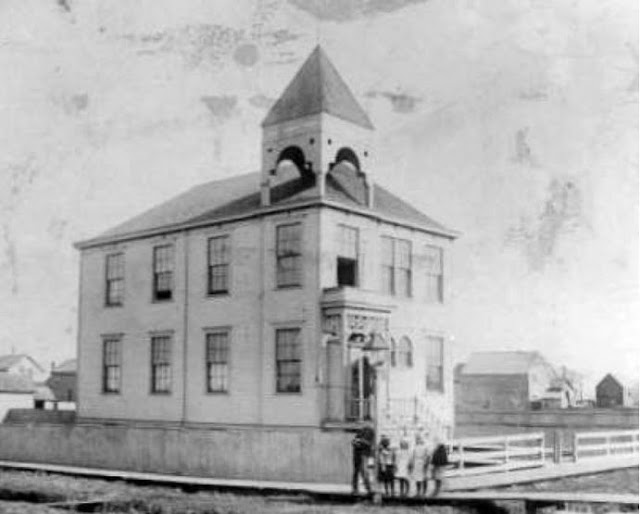Riverview was settled in 1833 and was a farming and industrial town. It was bounded by Oakton, River Road, Touhy, and Lee streets. The Illinois and Wisconsin Railroad made its first stop in the area in the fall of 1854. Riverview was incorporated in 1876 and had its own post office from1876-1925. By 1885 the town had four factories. Four years later, a fifth factory opened, making Riverview a boom town (today's Des Plaines).
In 1890, the Columbia Steel Car Works announced a new factory to be built south of Des Plaines, alongside the Wisconsin Central Railroad. Rumors circulated that a brewery would be built nearby.
The Magill Real Estate Company promised the Columbia Works, Sunshine Co., and Baltimore Tin-Plate would soon employ as many as 6,000 in another area known as Columbia, where the forest preserve now stands. None of the factories ever opened.
Columbia Steel Works, located at the southeast corner of Everett and Maple, stretching to Prospect & White, would have produced hopper cars and shipped them by the Wisconsin Central spur that ran alongside Circle Street. The factory was largely built in 1890 but never was finished.
The company's founder also started the Riverview Shoe Company in 1891, but work on its factory, adjacent to the Steel Car Works, was halted before a roof was even put on.
In 1891, the Western Coated Paper & Card Company opened a 75-by-250-foot factory on the north side of Everett Street between Linden and Orchard Street but went into bankruptcy in 1897. It burned to the ground on June 7, 1902. The nearby Kreh Chalk & Pencil Company was short-lived and also burned down.
The Western Brass Works, a hardware manufacturer, opened a factory on the west side of the Wisconsin Central at Howard Street in June 1892 but went bankrupt a year later. The building later became the Schaeffer Piano Manufacturing Company but burned to the ground on January 20, 1903, ironically one day after the foundation for its delayed sprinkler tank was finished.
Riverview Canning was built but lasted only three years. A small frame-planing mill was built but did not last long either.

Jones Woolen Mill opened in 1892 in a building along the Des Plaines River, some distance from the rest of Riverview. In 1896 the building became home to the Sunbeam Incandescent Lamp Company, an early competitor to Thomas Edison's light bulb dominance.
Riverview's failure to launch left its scattered cottages with little reason to be occupied. The community continued to struggle, and in 1925 the remaining residents asked Des Plaines to annex it. With the annexation, Des Plaines transitioned from a village to a city.
Riverview's Town Hall at the northwest corner of Illinois & Everett, which once housed its fire pump on its first floor and an auditorium for dances and meetings, was turned into a tool shed for Works Progress Administration (WPA) workers and was demolished in 1941. A house now stands on its site, while a church across the street still stands.
A block to the north, at the southwest corner of Illinois and Prospect, the first Riverview School stood until it was replaced in 1938 by the current South School, which took seven years to complete. The Wisconsin Central depot between Circle Street and the tracks was also demolished.
Riverview's street names even disappeared. Jefferson Avenue became Oakton street, Cuttle was changed to Riverview, Everitt to Everett, Park to Prospect, Centre to Stockton, Columbia to Howard, Gay to Spruce, Broadway to Ash, Washington to Pine, Franklin to Cora, Oak to Linden, Walnut to Sycamore, Jennie to Locust, Hamilton to Birch, May to Bennett, and Green to Kennicott.
Riverview was planned to be an industrial powerhouse but ended up as a subdivision. Nothing remains of the post office, fire station, train station or town hall. Today, all that remains of its fledgling industry is a building occupied by Schawk, Inc., a graphics service and brand design company, 1695 S. River Road, numerous identical frame houses, and a church.
After the Douglas Aircraft Plant construction during World War II, many of the streets were filled with economical but sturdy colonial brick duplexes, wiping out any remaining signs of the failed industries of 50 years prior. The one successful factory still stands today. In 1920, Safety Electric Company, a small manufacturer of electric light fixtures, moved into a building first occupied by Jones Woolen Mill and then by Sunbeam Incandescent Lamp Company. After Safety Electric left, the building was home to Jordan Manufacturing Company from 1964-1979. In 1982, the radically altered building, minus one floor, the front tower, and with rearranged windows, became home to Schawk.
Compiled by Dr. Neil Gale, Ph.D.







No comments:
Post a Comment
The Digital Research Library of Illinois History Journal™ is RATED PG-13. Please comment accordingly. Advertisements, spammers and scammers will be removed.